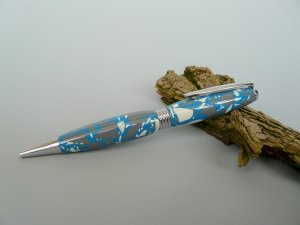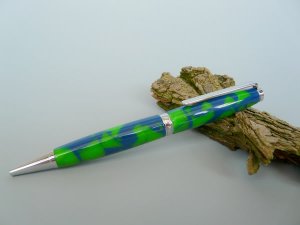KDM
Member
I trust this is not for a pen? At that size, it would make some kick-ass shaving brush handles!!!
Bottle stoppers?
I trust this is not for a pen? At that size, it would make some kick-ass shaving brush handles!!!



I made the mold with your design, but made it out of 3/4" poplar, and the silicon stuck and would not release. Is there a reason you used MDR? I used GE II and I had to dig the stuff out. FRANK
I made the mold with your design, but made it out of 3/4" poplar, and the silicon stuck and would not release. Is there a reason you used MDR? I used GE II and I had to dig the stuff out. FRANK
...and, I thought I should post a YouTube video of the blanks as I rotate them so you can see all round.
The first is the peachy skintone pieces remoulded in black resin.
The second is a red and blue swooshy thing of various shades. Looks like marble. Probably because I coloured it with enamel paint and it mixed in a strange way.
The third is the rainbow slivers moulded diagonally in black PR.
The fourth is the grey and mint green PR blanks I smashed up with a hammer. The pieces have been set in black PR.
I'm looking for names for each of these blanks. Does anyone have any suggestions?
I added 5 drops (maybe to few) per ounce to 8 ozOoooh. Did you catalyse it? The mixing in of teh MEKP catalyst should have caused it to warm up sufficiently to start the curing reaction.....
I tried doing some casting with the resin that Michaels sells. It has been 2 days in the garage (unheated) you guys in Virginia know how cold it has been out and it is still like jello. I have it in a 8 oz tupperware container. Maybe I should bring it in the house?
I tried doing some casting with the resin that Michaels sells. It has been 2 days in the garage (unheated) you guys in Virginia know how cold it has been out and it is still like jello. I have it in a 8 oz tupperware container. Maybe I should bring it in the house?
I tried doing some casting with the resin that Michaels sells. It has been 2 days in the garage (unheated) you guys in Virginia know how cold it has been out and it is still like jello. I have it in a 8 oz tupperware container. Maybe I should bring it in the house?
A few months back I made a hotbox from scrap materials and I use if for a lot of things
drying painted tubes
heating PR
drying wood blanks
post-cure of PR
etc.
here is my OP on making it
http://www.penturners.org/forum/showthread.php?t=58870
I have five molds in it right now. 150 deg with 1 60 watt and 1 75 watt light bulb.
I tried doing some casting with the resin that Michaels sells. It has been 2 days in the garage (unheated) you guys in Virginia know how cold it has been out and it is still like jello. I have it in a 8 oz tupperware container. Maybe I should bring it in the house?
A few months back I made a hotbox from scrap materials and I use if for a lot of things
drying painted tubes
heating PR
drying wood blanks
post-cure of PR
etc.
here is my OP on making it
http://www.penturners.org/forum/showthread.php?t=58870
I have five molds in it right now. 150 deg with 1 60 watt and 1 75 watt light bulb.
Three two part questions:
1. How long do you leave the lights on (overnight, couple hrs)?
2. What kind of vent is on the top? Just a hole with a loose piece of cardboard.
3. Will any cardboad do (display boards, dishwasher box, etc)?
